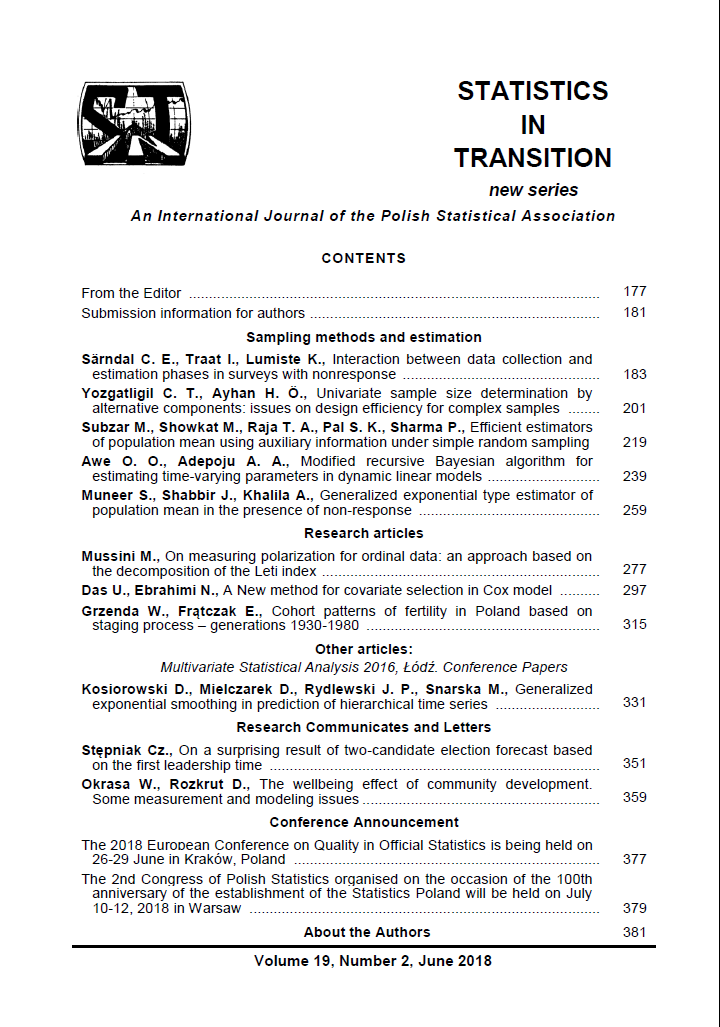ARTICLE
ABSTRACT
This paper deals with the measurement of polarization for ordinal data. Polarization in the distribution of an ordinal variable is measured by using the decomposition of the Leti heterogeneity index. The ratio of the between-group component of the index to the within-group component is used to measure the degree of polarization for an ordinal variable. This polarization measure does not require imposing cardinality on ordered categories to quantify the degree of polarization in the distribution of an ordinal variable. We address the practical issue of identifying groups by using classification trees for ordinal variables. This tree-based approach uncovers the most homogeneous groups from observed data, discovering the patterns of polarization in a data-driven way. An application to Italian survey data on self-reported health status is shown.
KEYWORDS
polarization, ordinal data, Leti index, classification trees
REFERENCES
ALLISON, R. A., FOSTER J., (2004). Measuring health inequality using qualitative data, Journal of Health Economics 23, pp. 505–524.
APOUEY, B., (2007). Measuring health polarization with self-assessed health data, Health Economics 16, pp. 875–894.
BANCA D’ITALIA, Survey on Household Income and Wealth 2010, Rome (2012). http://www.bancaditalia.it/statistiche/indcamp/bilfait/boll_stat;internal&action=_setlanguage.action?LANGUAGE=en.
BLAIR, J., LACY, M. G., (1996). Measures of Variation for Ordinal Data as Functions of the Cumulative Distribution, Perceptual and Motor Skills 82, pp. 411–418.
BLAIR, J., LACY, M. G., (2000). Statistics of Ordinal Variation, Sociological Methods & Research 28, pp. 251–280.
BOSSERT, W., SCHWORM, W., (2008). A Class of Two-Group Polarization Measures, Journal of Public Economic Theory 10, pp. 1169–1187.
BREIMAN, L., FRIEDMAN, J. H., OLSHEN, R. A. , STONE, C. J., (1984). Classification and regression trees. Chapman & Hall/CRC press, Boca Raton.
DEUTSCH, J., FUSCO, A., SILBER, J., (2013). The BIP trilogy (Bipolarization, Inequality and Polarization): one saga but three different stories. Economics: The Open-Access, Open-Assessment E-Journal 7, pp. 2013–2022. http://www.economics-ejournal.org/economics/journalarticles/2013-22.
DUCLOS, J. Y., ESTEBAN, J. M., RAY, D., (2004). Polarization: Concepts, measurement, estimation, Econometrica 72, pp. 1737–1772.
ESTEBAN, J. M., RAY, D., (1994). On the measurement of polarization, Econometrica 62, pp. 819–851.
FOSTER, J. E., WOLFSON, M. C., (2010). Polarization and the decline of the middle class: Canada and the U.S., Journal of Economic Inequality 8, pp. 247–273.
FUSCO, A., SILBER, J., (2014). On social polarization and ordinal variables: the case of self-assessed health, European Journal of Health Economics 15, pp. 841–851.
GALIMBERTI, G., SOFFRITTI, G., DI MASO, M., (2012). Classification Trees for Ordinal Responses in R: The rpartScore Package, Journal of Statistical Software 47, pp. 1–25.
GIGLIARANO, C., MOSLER, K., (2009). Constructing indices of multivariate polarization, Journal of Economic Inequality 7, pp. 435–460.
GINI, C., (1954). Variabilita e concentrazione, Veschi, Rome.
GRILLI, L., RAMPICHINI, C., (2002). Scomposizione della dispersione per variabili statistiche ordinali, Statistica 62, pp. 111–116.
IDLER, E., BENYAMINI, Y., (1997). Self-rated health and mortality: a review of twenty-seven community studies, Journal of Health and Social Behaviour 38, pp. 21–37.
KAKWANI, N., WAGSTAFF, A., VAN DOORSLAER, E., (1997). Socioeconomic inequalities in health: Measurement, computation, and statistical inference, Journal of Econometrics 77, pp. 87–103.
JENKINS, S. P., (1995). Did the Middle Class Shrink during the 1980s? UK Evidence from Kernel Density Estimates, Economics Letters 49, pp. 407–413.
LEIK, R. K., (1966). A Measure of Ordinal Consensus, The Pacific Sociological Review 9, pp. 85–90.
LETI, G., (1983). Statistica descrittiva, il Mulino, Bologna.
LV, G., WANG, Y., XU, Y., (2015). On a new class of measures for health inequality based on ordinal data, Journal of Economic Inequality 13, pp. 465–477.
MUSSINI, M., (2016). On measuring income polarization: an approach based on regression trees, Statistics in Transition – new series 17, pp. 221–236.
PALACIOS-GONZÁLEZ, F., GARCÍA-FERNÁNDEZ, R. M., (2012). Interpretation of the coefficient of determination of an ANOVA model as a measure of polarization, Journal of Applied Statistics 39, pp. 1543–1555.
PERMANYER, I., D’AMBROSIO, C., (2015). Measuring Social Polarization with Ordinal and Categorical Data, Journal of Public Economic Theory 17, pp. 311–327.
PICCARRETA, R., (2008). Classification trees for ordinal variables, Computational Statistics 23, pp. 407–427.
REARDON, S. F., (2009). Measures of ordinal segregation, in Y. Flückiger, S. F.,Reardon and J., Silber (eds.), Occupational and Residential Segregation, Research on Economic Inequality 17, pp. 129–155, Emerald, Bingley.
SHORROCKS, A. F., (1980). The Class of Additively Decomposable Inequality Measures, Econometrica 48, pp. 613–625.
SHORROCKS, A. F., (1984). Inequality Decomposition by Population Subgroups, Econometrica 52, pp. 1369–1385.
SILBER, J., YALONETZKY, G., (2011). On Measuring Inequality in Life Chances when a Variable is Ordinal, in Juan Gabriel Rodríguez (ed.) Inequality of Opportunity: Theory and Measurement, Research on Economic Inequality 19, pp.77–98, Emerald, Bingley.
WANG, Y. Q., TSUI, K. Y., (2000). Polarization orderings and new classes of polarization indices, Journal of Public Economic Theory 2, pp. 349–363.
WOLFSON, M. C., (1994). When Inequalities Diverge?, American Economic Review 84, pp. 353–358.
YITZHAKI, S., (2010). Is there room for polarization?, The Review of Income and Wealth 56, pp. 7–22.
ZHANG, X., KANBUR, R., (2001). What difference do polarization measures make? An application to China, Journal of Development Studies 37, pp. 85–98
